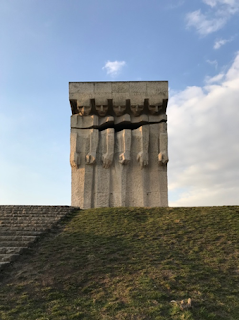After coming back from Poland, I have been finding it hard to give myself space and time to process all that we witnessed. Feeling bombarded by family, friends, and professors with well-meaning questions about the trip and our experiences has been overwhelming. I keep coming back to the phrase “the more I learn, the less I understand”, which was a title of a book I saw in the book store at Birkenau. The more we learned and saw, the less I understand how all of this destruction could have happened. I found it difficult to come make sense of what the destruction of an entire group of people looks like, until we stood next to a pond filled with ashes. That is what destruction looks like.
 |
|
Memorial
next to pond at Auschwitz II-Birkenau
|
In class before traveling to Poland, we spoke about conceptualizing 6 million people. We spoke about different movements started by teachers to help educate others about the Holocaust and to help understand how devasting the scope of the Holocaust was. One of these projects was the paper clip project, where a school tried to collect 6 million paper clips to represent all the people murdered in the Holocaust. This was an attempt to not only conceptualize what 6 million people looks like, but to also understand that each of those paper clips represented an individual. Dr. Procario-Foley stressed in class to not only remember the individual, but to understand that each individual had a network of people that were affected. Each individual was a mother, a father, a daughter, a son.
 |
|
A
photo found in a suitcase hidden in Auschwitz II-Birkenau
|
I found the ways in which different communities and places memorialized the ones they lost impactful. Some were more emotionally impactful, which others strived to draw attention to the individual; by remembered that reach person was a man, women or child, not a nameless prisoner.
 |
|
Memorial
at Plaszow Concentration Camp
|












0 comments:
Post a Comment